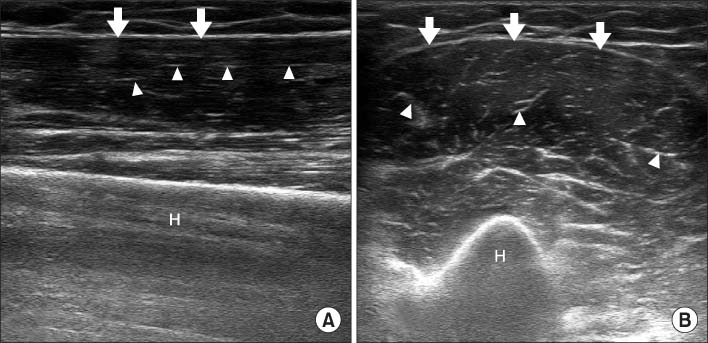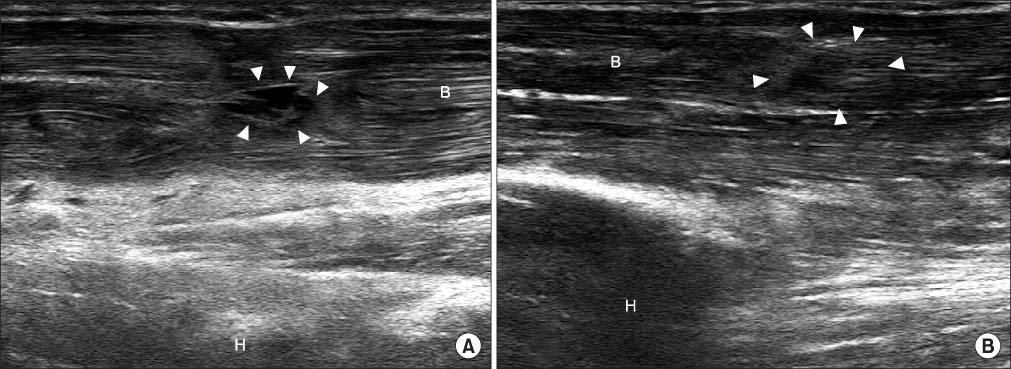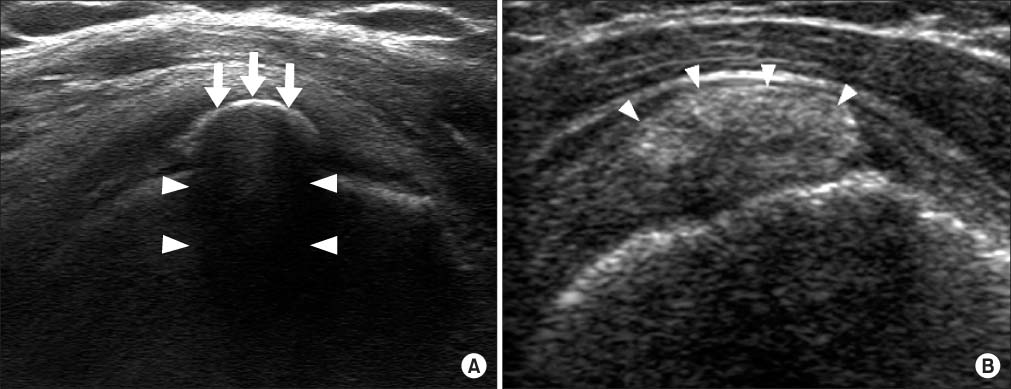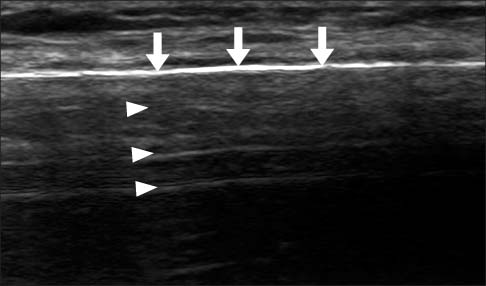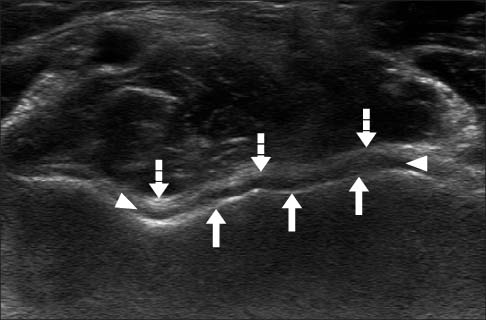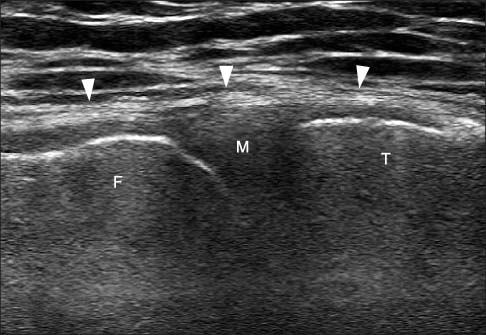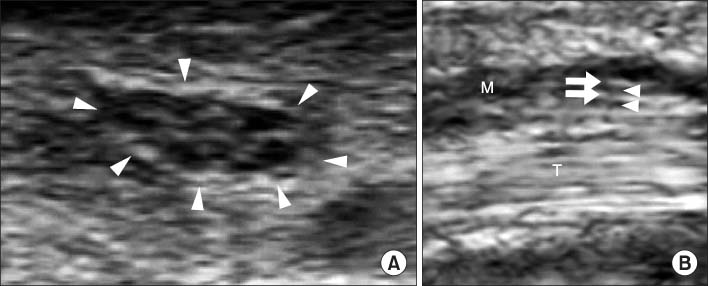J Korean Orthop Assoc.
2013 Oct;48(5):334-341. 10.4055/jkoa.2013.48.5.334.
Ultrasonographic Findings of Musculoskeletal Tissues
- Affiliations
-
- 1Department of Orthopedic Surgery, Korea University College of Medicine, Seoul, Korea. drshoulder@korea.ac.kr
- KMID: 1494145
- DOI: http://doi.org/10.4055/jkoa.2013.48.5.334
Abstract
- In order to accurately diagnose lesions of musculoskeletal tissue, evaluation not only of the abnormality of the bone, but the condition of soft tissue is important. Magnetic resonance imaging has been widely used in evaluation of the state of soft tissue, however, it has the disadvantage that testing is expensive and real-time scanning is not possible. In recent years, ultrasonography has been used for evaluation of musculoskeletal tissue and its usefulness has shown a gradual increase. The ultrasound image is determined by the tissue specific acoustic impedance and other factors. Highly reflective tissues such as bone, calcification, ligament, and tendon are expressed as hyperechoic images, and less reflective tissues such as muscle and nerve are expressed as hypoechoic images.
Keyword
MeSH Terms
Figure
Cited by 1 articles
-
Evaluation of Pain and Ultrasonography on Shoulder in Poliomyelitis Wheelchair Basketball Players
Kil-Byung Lim, Jeehyun Yoo, Hong-Jae Lee, Ji Heoung Lee, Yong-Geol Kwon
Korean J Sports Med. 2014;32(1):20-26. doi: 10.5763/kjsm.2014.32.1.20.
Reference
-
1. Moosmayer S, Smith HJ. Diagnostic ultrasound of the shoulder--a method for experts only? Results from an orthopedic surgeon with relative inexpensive compared to operative findings. Acta Orthop. 2005; 76:503–508.2. Lehto M, Alanen A. Healing of a muscle trauma. Correlation of sonographical and histological findings in an experimental study in rats. J Ultrasound Med. 1987; 6:425–429.
Article3. Campbell RS, Grainger AJ. Current concepts in imaging of tendinopathy. Clin Radiol. 2001; 56:253–267.
Article4. Khan KM, Bonar F, Desmond PM, et al. Victorian Institute of Sport Tendon Study Group. Patellar tendinosis (jumper's knee): findings at histopathologic examination, US, and MR imaging. Radiology. 1996; 200:821–827.5. Fornage BD, Rifkin MD, Touche DH, Segal PM. Sonography of the patellar tendon: preliminary observations. AJR Am J Roentgenol. 1984; 143:179–182.
Article6. Maffulli N, Regine R, Carrillo F, Capasso G, Minelli S. Tennis elbow: an ultrasonographic study in tennis players. Br J Sports Med. 1990; 24:151–155.
Article7. Martinoli C, Derchi LE, Pastorino C, Bertolotto M, Silvestri E. Analysis of echotexture of tendons with US. Radiology. 1993; 186:839–843.
Article8. Farin PU, Jaroma H, Harju A, Soimakallio S. Medial displacement of the biceps brachii tendon: evaluation with dynamic sonography during maximal external shoulder rotation. Radiology. 1995; 195:845–848.
Article9. Fessell DP, Vanderschueren GM, Jacobson JA, et al. US of the ankle: technique, anatomy, and diagnosis of pathologic conditions. Radiographics. 1998; 18:325–340.
Article10. Prato N, Abello E, Martinoli C, Derchi L, Bianchi S. Sonography of posterior tibialis tendon dislocation. J Ultrasound Med. 2004; 23:701–705.
Article11. Barata I, Spencer R, Suppiah A, Raio C, Ward MF, Sama A. Emergency ultrasound in the detection of pediatric long-bone fractures. Pediatr Emerg Care. 2012; 28:1154–1157.
Article12. Rabiner JE, Friedman LM, Khine H, Avner JR, Tsung JW. Accuracy of point-of-care ultrasound for diagnosis of skull fractures in children. Pediatrics. 2013; 131:e1757–e1764.
Article13. Rabiner JE, Khine H, Avner JR, Friedman LM, Tsung JW. Accuracy of point-of-care ultrasonography for diagnosis of elbow fractures in children. Ann Emerg Med. 2013; 61:9–17.
Article14. Matsuyama J, Ohnishi I, Sakai R, et al. A new method for evaluation of fracture healing by echo tracking. Ultrasound Med Biol. 2008; 34:775–783.
Article15. Weiss DB, Jacobson JA, Karunakar MA. The use of ultrasound in evaluating orthopaedic trauma patients. J Am Acad Orthop Surg. 2005; 13:525–533.
Article16. Smith J, Dahm DL, Newcomer-Aney KL. Role of sonography in the evaluation of unstable os acromiale. J Ultrasound Med. 2008; 27:1521–1526.
Article17. Peetrons P, Creteur V, Bacq C. Sonography of ankle ligaments. J Clin Ultrasound. 2004; 32:491–499.
Article18. Brasseur JL, Morvan G, Godoc B. Dynamic ultrasonography. J Radiol. 2005; 86:1904–1910.19. Buchberger W, Schön G, Strasser K, Jungwirth W. High-resolution ultrasonography of the carpal tunnel. J Ultrasound Med. 1991; 10:531–537.
Article
- Full Text Links
- Actions
-
Cited
- CITED
-
- Close
- Share
- Similar articles
-
- The Usefulness of Ultrasonographic Evaluation in the Musculoskeletal Disease
- Fetal Musculoskeletal Malformations with a Poor Outcome: Ultrasonographic, Pathologic, and Radiographic Findings
- Ultrasonographic and Physical Examination to Investigate the Cause of Painful Hemiplegic Shoulder
- Soft Tissue Masses: Ultrasonographic Findings
- Postoperative ultrasonography of the musculoskeletal system

